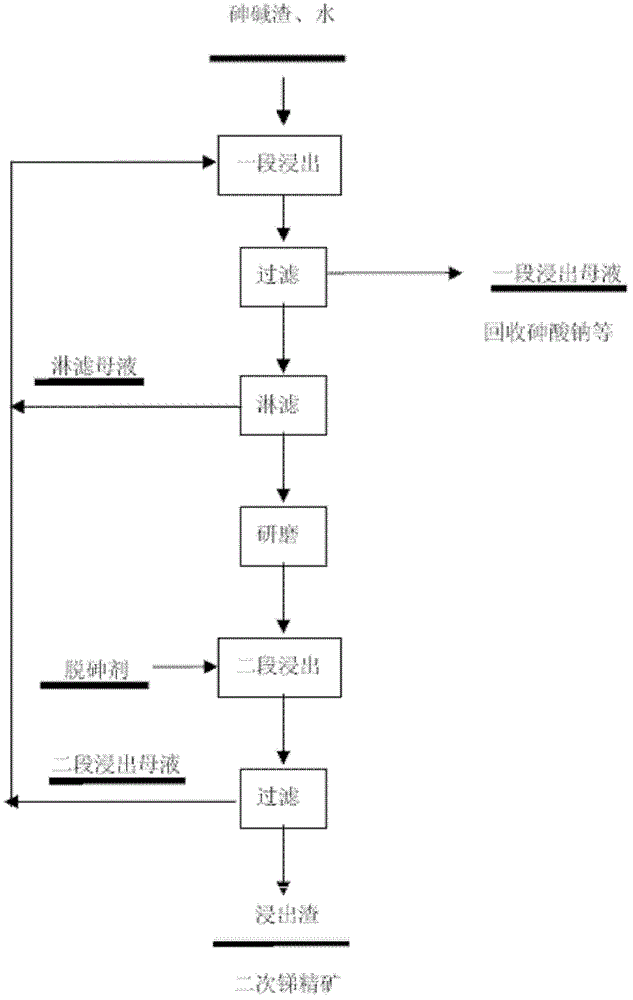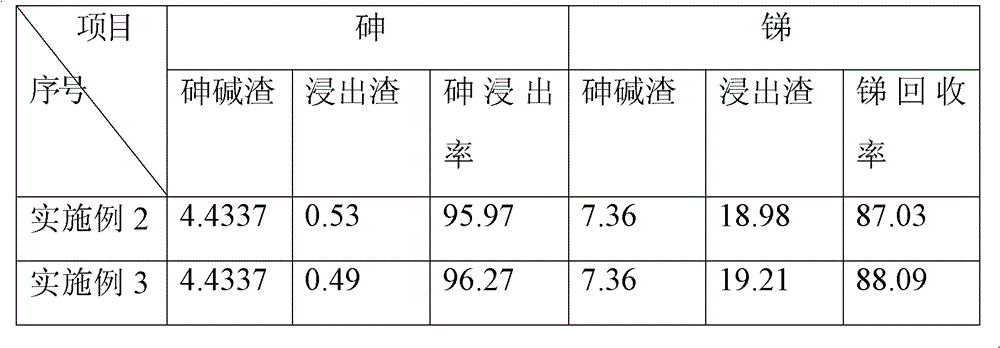Method for dearsenization through hot leaching of arsenic alkali residue water
An arsenic alkali residue and leaching technology is applied in the field of waste residue treatment of non-ferrous metal smelting, which can solve the problems of restricting the sustainable development of antimony metallurgy industry, waste of antimony, arsenic, and alkali backlog, safety and environmental pollution, etc. Recovery rate, the effect of reducing the arsenic content
- Summary
- Abstract
- Description
- Claims
- Application Information
AI Technical Summary
Problems solved by technology
Method used
Image
Examples
Embodiment 1
[0041] Example 1: only one hydrothermal leaching
[0042] For a certain arsenic-alkali slag, its composition is shown in Table 1, and the phase composition of arsenic in the arsenic-alkali slag before leaching treatment is shown in Table 2.
[0043] Crush the arsenic-alkali slag to less than 5mm, take 400g of arsenic-alkali slag and carry out hydrothermal leaching under the conditions of 50°C, a solid-to-liquid ratio of 1 / 2, and a leaching time of 90 minutes. Filter the leaching system under heat preservation to separate the leaching liquid from the slag. The leaching residue is leached with 200ml of 50°C hot water to reduce the moisture content of the filtering residue to 42%. The leaching residue is dried at 105°C to measure the leaching The phase composition of arsenic in the slag is shown in Table 2. After the arsenic-alkali slag was leached by hydrothermal treatment once, the arsenic content in the slag was 0.923%, and the leaching rate was 92.82%.
[0044] Table 1 Compo...
Embodiment 2
[0048] Example 2: Twice hydrothermal leaching without adding arsenic removal agent
[0049] Crush the arsenic-alkali slag to less than 5mm, take 300g of arsenic-alkali slag and carry out hydrothermal leaching at 50°C and a solid-to-liquid ratio of 1 / 5 for 60 minutes, and suction-filter the leaching system to separate the leachate from the slag and make the filter slag contain water rate dropped to 37.6%.
[0050] The leaching residue was subjected to the second hydrothermal leaching for 60 minutes under the conditions of leaching temperature of 85°C and solid-to-liquid ratio of 1 / 2. Filter the leaching system to reduce the moisture content of the filter residue to 41.5%, and dry the leaching residue at 105°C. The contents of arsenic and antimony in the arsenic-alkali slag before and after leaching are shown in Table 3. After twice leaching, the arsenic-alkali slag is The arsenic content is 0.53%, and the leaching rate is 95.97%.
Embodiment 3
[0051] Example 3: Twice hydrothermal leaching without adding arsenic removal agent
[0052] Crush the arsenic-alkali slag to less than 5mm, take 400g of arsenic-alkali slag and carry out hydrothermal leaching at 95°C and a solid-to-liquid ratio of 1 / 2 for 60 minutes, and suction filter the leaching system under heat preservation conditions to separate the leachate from the slag. The leached residue was leached with 200ml of hot water at 95°C to reduce the moisture content of the filtered residue to 42.4%.
[0053] Grind the leaching slag to make its particle size less than 0.35 mm (42 mesh), and conduct the second hydrothermal leaching for 120 min at the leaching temperature of 95° C. and the solid-to-liquid ratio of 1 / 5. The leaching system was filtered to reduce the moisture content of the filter residue to 35%, and the leaching residue was dried at 105°C. The contents of arsenic and antimony in the arsenic-alkali slag before and after leaching were shown in Table 3. After t...
PUM
| Property | Measurement | Unit |
|---|---|---|
| particle size | aaaaa | aaaaa |
Abstract
Description
Claims
Application Information
 Login to View More
Login to View More - R&D
- Intellectual Property
- Life Sciences
- Materials
- Tech Scout
- Unparalleled Data Quality
- Higher Quality Content
- 60% Fewer Hallucinations
Browse by: Latest US Patents, China's latest patents, Technical Efficacy Thesaurus, Application Domain, Technology Topic, Popular Technical Reports.
© 2025 PatSnap. All rights reserved.Legal|Privacy policy|Modern Slavery Act Transparency Statement|Sitemap|About US| Contact US: help@patsnap.com



